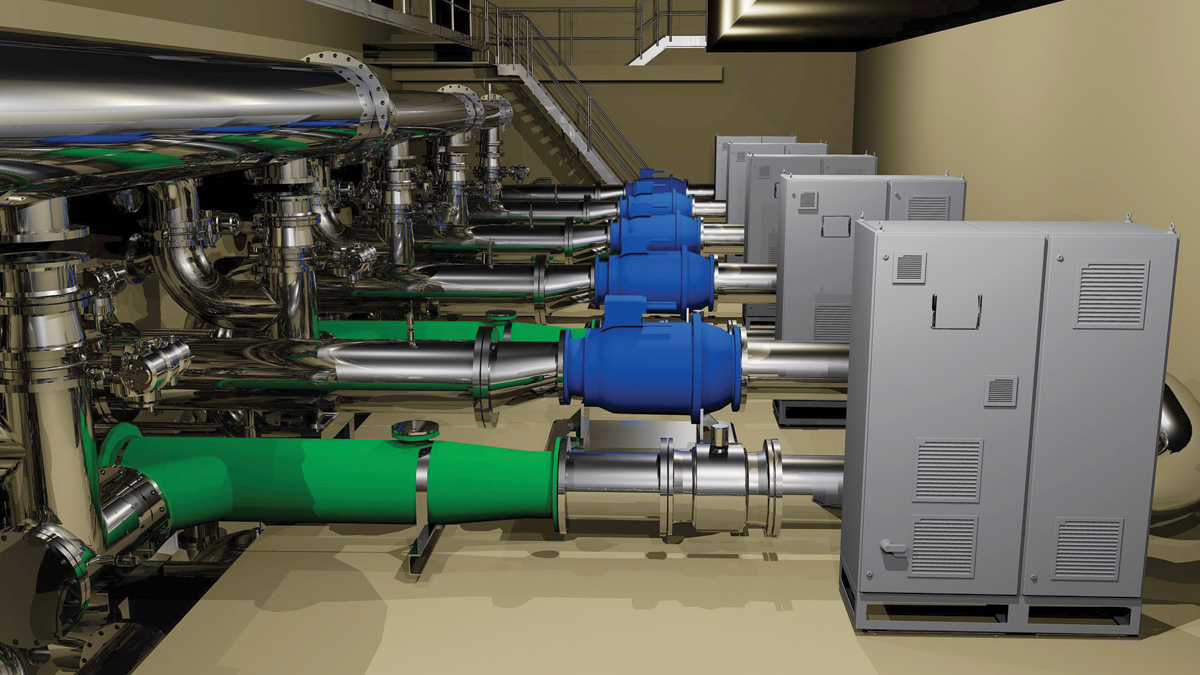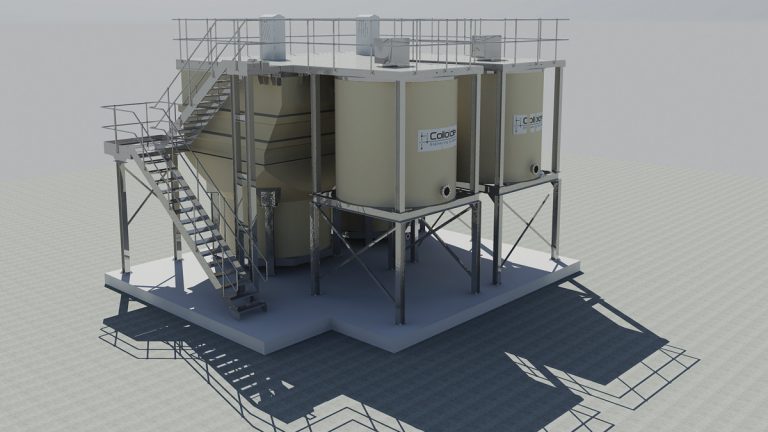Farlington WTW (2016)

The 5 (No.) UV reactors & flow booster pumps - Courtesy of Trant Engineering Ltd
Portsmouth Water’s Farlington WTW dates back to 1909 and provides potable water to more than 280,000 people and many businesses in the Portsmouth and Havant area. Farlington’s supply is derived from the springs, which are believed to be the largest spring source in Europe. Raw water is chlorinated at the spring source pumping stations. At Farlington WTW, water gravitates from the inlet splitter chamber to the thirteen rapid gravity filters. When the raw water quality deteriorates, aluminium sulphate is dosed upstream of the rapid gravity filters. Filtered water then gravitates into a common filtered water outlet channel where it is chlorinated. The filtered and chlorinated water then gravitates to the membrane filtration plant before being dosed with phosphoric acid upstream of the contact tank. All wastewater flows from the treatment plant are currently discharged off site.
Background
In April 2015 Portsmouth Water issued a tender based on an outline design for treatment and process facilities to address the aforementioned cryptosporidium and discharge mitigation issues; the solution developed consisted of the following:
- Ultraviolet (UV) irradiation facility at Farlington WTW for the inactivation of cryptosporidium, to be installed within the existing membrane filter building to replace the existing membranes.
- Wastewater recirculation facility to separate supernatant flow from process solids and return it to the head of the works.
Undertakings
The NEC3 ECC Option C (Target Cost with Activity Schedule) contract was awarded to Trant Engineering Ltd in August 2015 as an EPC Contract.
Trant Engineering carried out the following detailed design in-house; process, mechanical, electrical and ICA, and are responsible for the civil, mechanical, electrical installation and commissioning.
Trant Systems Electrical (TSE) is responsible for the design, manufacturing, installation and commissioning of the new motor control centre (MCC) and modifications to an existing MCC for the works.

Elevation of the sludge balancing tank, lamella clarifiers with integral thickeners, and centrifuge building – Courtesy of Trant Engineering Ltd
UV treatment
The membrane filtration plant (MFP) was installed in 2003 as the only viable DWI approved process to remove cryptosporidium oocysts from the filtered water prior to entering the service reservoirs. However the membrane plant sub-modules were deemed to be nearing the end of their serviceable life. The DWI revised the standard in 2008 to permit the use of UV disinfection as a barrier to inactivate the oocysts.
The initial outline tender design to treat up to a maximum of 100Ml/d included a significant number of potential risks associated with the construction of a new UV treatment plant within and around the existing operational membrane treatment plant building. Following an initial review by Trant Engineering it was decided to investigate an alternative design approach.
The alternative design that was eventually developed is based on the provision of 5 (No.) UV reactors streams (4 duty/1 standby) instead of the 3 (No.) UV reactors streams (2 duty/1 standby) proposed within the outline tender design.
The revised design drastically reduced both the construction risks and the operational risks, provided greater operational flexibility and security and enabled the phased migration from the current membrane treatment process to the new UV treatment process whilst delivering considerable savings in TOTEX.
The final UV plant design developed using 3D technology by Trant Engineering within the existing membrane plant building utilises the existing inlet and outlet mains, membrane plant headers plus existing tank connections for ‘run to waste’ and drainage operations.
The original MFP plant comprised 6 (No.) identical treatment streams plus provision for a future additional treatment stream. One of the key elements of the Trant Engineering design was to minimise interference with the operation of the existing MFP and by extending the existing inlet and outlet headers it is possible to install, test and commission the first UV treatment stream whilst leaving the existing 6 (No.) MF streams fully operational.
Following the successful testing and commissioning of this first UV stream, to provide UV treatment of flows up to 25Ml/d, the first of the 6 (No.) MF streams can be taken out of service, dismantled and removed. This then allows the second UV stream to be installed, tested and commissioned to provide a further 25ml/d of UV treatment capacity.
This process is then repeated until all 6 (No.) MF streams have been removed and the 5 (No.) UV treatment streams are fully operational. These carefully programmed sequential operations ensure a very gradual migration from MF treatment to UV treatment whilst providing secure and continuous treatment to supply.

(left) Surface stripping of lamella/centrifuge building and (right) Trant Engineering site offices installed – Courtesy of Trant Engineering
The reactors
The 5 (No.) identical 25Ml/d UV reactors installed under this contract are low pressure units by ATG Technology each with a 316 stainless steel reactor chamber housing 16 (No.) x 800W amalgam UV lamps with automatic wiper system and validated UV monitoring. Each of the UV streams is provided with a magnetic flow meter, inline axial mixed flow Bedford booster pump, manual and actuated valves together with the associated 316 stainless steel pipework. Each stream also has a dedicated UV local control panel and UPS.
Wastewater treatment
Currently, approximately 94% of the wastewater discharge from site is generated from backwashing of the existing membrane filters (MFs) and rapid gravity filters (RGFs). As the membrane filters are to be decommissioned, recirculating the RGF washwater flows would remove the vast majority of wastewater discharges off-site.
There are 13 (No.) RGFs which periodically require backwashing to maintain water quality. The backwash water drains through channels from the filters, through existing chambers and currently bypasses 2 (No.) washwater holding tanks and exits the site.
The 2 (No.) existing washwater holding tanks have not been used for more than 20 years, with the manual inlet penstocks to each tank closed, and the manual bypass penstock valve open.
The washwater tanks and inlet penstocks are to be refurbished to allow flow to enter the tanks. An overflow weir is to be installed in the reception chamber and the bypass penstock left open.
In each tank there will be a variable speed drive (VSD) submersible pump installed, with a common discharge that will sequentially pump the contents of the tanks to the 2 (No.) new lamella thickeners (duty/duty), whereby solids will gravitate into each integral thickener, and supernatant (clarified water) weirs then gravitates to the existing inlet chamber at the head of the works if <10NTU. If supernatant is >10NTU then flow will be directed back to the washwater tanks. Polymer is dosed into the feed line to the lamellas, from dosing plant (duty/standby pumps) located within the centrifuge building.

Colloide lamellas – Image rendered and supplied by Trant Engineering
Sludge (raw water solids), will be removed by the 2 (No.) lamella sludge transfer pumps (duty/standby) via actuated valves and pumped into the new sludge balancing tank. The sludge balancing tank contents will be mixed by the new external sludge balancing tank external mixing pump.
2 (No.) centrifuge feed pumps (duty/standby) will be installed, feeding the 2 (No.) new centrifuges (duty/standby) located within the new centrifuge building. The sludge is then dewatered to a minimum of 15% dry solids w/w, where the ‘cake’ drops into a skip beneath the centrifuges, and the centrate (liquid waste) is either recycled to the washwater tanks or discharged to the sewer pipeline. Polymer is dosed into the feed line to each centrifuge from dosing plant (duty/standby pumps) located within the centrifuge building.
Polymer is made up using makeup units from which the lamella and centrifuge dosing pumps draw from to their respective systems, with the additional facility of being a duty/standby system.
Water supplying the polymer makeup units, polymer dilution (dosing pumps), hose points and centrifuge washdown is boosted by a new service water booster set located within the UV building.
The original outline design was re-designed by Trant Engineering to reduce the need for a second cake reception building and lessen the aesthetic impact on site, with a greatly reduced footprint yet still allowing for access to existing water mains and sufficient maintenance access to the new equipment.
Conclusion
The circa £4.0m project started in August 2015 with completion due in August 2017. Collaborative working and good communication between Trant Engineering Ltd and Portsmouth Water is ensuring that Portsmouth Water get the high quality project they demand whilst introducing cost savings and meeting the undertaking date.
Farlington WTW – UV Treatment & Discharge Mitigation: Key participants
- Main contractors: Trant Engineering Ltd
- GPR/utilities surveyors: 40Seven
- Civil Design Consultant: Godsell Arnold Partnership Ltd
- Chemical dosing & sampling: Chemidose DMS
- MCC/systems integration: Trant Systems Electrical
- UV reactors: ATG UV Technology
- Stainless steel pipework: ABC Stainless
- UV Booster pumps: Bedford Pumps
- Lamella thickening plant: Colloide Engineering
- Submersible pumps: Xylem
- Polymer plant: MSE Hiller
- Flowmeters: ABB
- Decanter centrifuges: MSE Hiller
- Service water booster set: KGN Pillinger
- Centrifuge building: Romsey Steelwork & Cladding
- Valves: Glenfield Invicta
- Thickened sludge holding tank: Hayes GFS Ltd
- DI/FBE pipework: Saint Gobain PAM UK
- Water quality monitors: Swan Analytical UK Ltd
Trant Engineering provided a follow up case study on the progress at Farlington WTW in UK Water Projects 2017.










